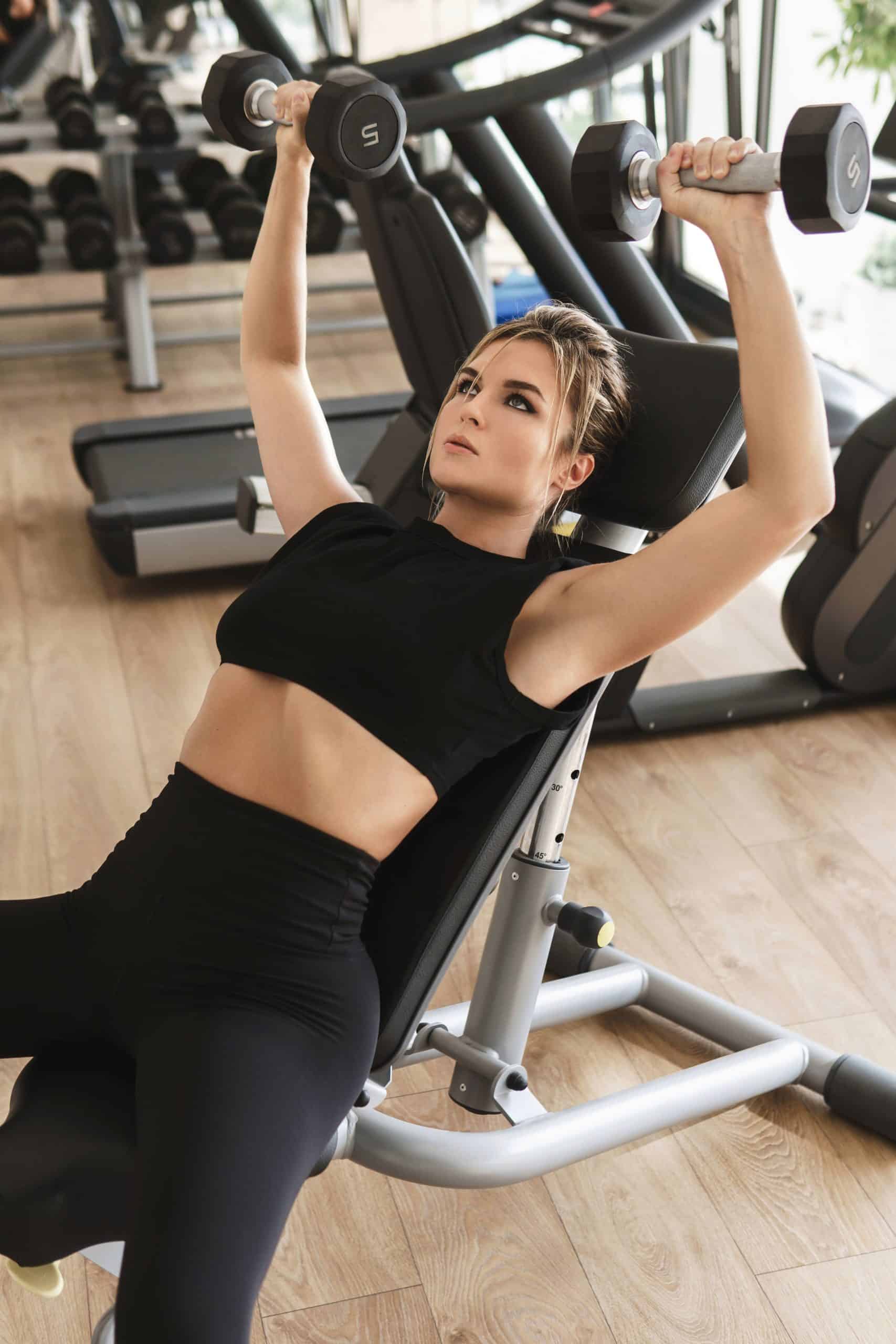
Seated Incline Dumbbell Curl tips tricks
To master the seated incline dumbbell curl, proper form, and technique are key. Follow these steps:
- Sit on an incline bench with your feet firmly on the ground.
- Hold a weight in each hand and extend your arms with palms facing away from you.
- Slowly curl the dumbbells to your shoulders.
- Squeeze your biceps at the top and then lower the weights back down.
Focus on controlled movements rather than fast jerky ones. This ensures you’re engaging your muscles through the whole range of motion. Also, avoid swinging or using momentum to lift the weights as this can lead to injury.
This exercise has been popular for decades. Bodybuilding pioneers first discovered its effectiveness for building impressive biceps. Athletes and fitness enthusiasts have since adopted it as a reliable method for strong, sculpted arms.
Benefits of Seated Incline Dumbbell Curl
Seated incline dumbbell curls are great for targeting and building bicep muscles. It enables a greater stretch of the biceps, leading to improved muscle fiber recruitment and growth. Here’s what this exercise offers:
- Greater Muscle Activation: Seated incline dumbbell curls put the biceps in an advantageous, active position, meaning more muscle activation than traditional standing curls.
- Isolation: Sitting on an incline bench helps with isolating the biceps, as the back & shoulders are stabilized to stop any cheating movements.
- Improved Strength/Flexibility: Not only does it help build bicep strength, but also improves flexibility. The controlled movement helps with proper form & technique, and gradual weight increase.
To get the most from this exercise, bear these tips in mind:
- Proper Form: Keep your back flat against the bench to maximize the isolation of your biceps. Don’t use momentum or cheat.
- Breathe: Exhale while lifting the dumbbells & inhale while lowering them. Doing this helps maintain stability & focus.
- Increase Weight Gradually: Start with lighter weights & increase as your strength increases. This helps stimulate muscle growth.
Now you know the basics of seated incline dumbbell curls! Add them to your routine and watch your biceps strengthen & define. Make sure to check with a fitness professional before starting any new workout.
Equipment Needed
To perform the Seated Incline Dumbbell Curl, you will need specific equipment. These tools are essential for executing the exercise and achieving results.
- You will need a pair of dumbbells. Choose a weight that is suitable for your fitness level and goals. Make sure the dumbbells are comfortable and secure.
- You’ll need a workout bench with an adjustable incline feature. This will let you position yourself at an angle that targets your biceps. Make sure the bench is stable and supports your back.
It’s also recommended to use a mat or towel on the bench for comfort. This will cushion your body and reduce any discomfort from hard surfaces.
You should also wear appropriate workout attire and shoes for safety and comfort. Choose clothing that allows for movement and shoes that provide stability and grip.
Additionally, it’s important to stay hydrated. Have a bottle of water nearby during your workout. This helps performance and reduces the risk of muscle cramps or fatigue.
An interesting story related to this exercise: One day at the gym, I saw someone having trouble with their Seated Incline Dumbbell Curls due to faulty equipment. The bench they were using wasn’t adjustable. This highlighted the importance of reliable equipment that meets your individual needs.
Proper Form and Technique
- Position yourself on an incline bench. Keep your back straight and your feet on the ground.
- Hold a dumbbell in each hand, palms forward, arms outstretched.
- Slowly curl the weights up to your shoulders. Keep your elbows close. Avoid jerking or swinging.
- Pause at the top, squeezing your biceps.
- Then lower the weights back to the start.
Remember: stay in control, don’t use too much weight, and take breaths. These details help you make the most of the Seated Incline Dumbbell Curl.
For added benefits: focus on keeping your elbows in position. Increase the weight as you go. And always warm up before heavy lifts. These suggestions help you optimize muscle recruitment and lift safely.
Variations and Modifications
Various approaches exist to alter and mix up the seated incline dumbbell curl exercise. This offers the opportunity to customize it to reach individual fitness goals. An example is the alternating seated incline dumbbell curl, where each arm is worked separately. Another option is the hammer grip seated incline dumbbell curl, which involves keeping the palms facing each other. Moreover, adjusting the incline of the bench impacts different muscle groups.
Options such as resistance bands and cable machines also enable those lacking dumbbells to exercise. These modifications give a chance to challenge and activate different muscles while doing the same movement pattern. Holds or pauses at different points during the exercise can boost muscle activation and generate extra tension.
I once saw someone in the gym struggling with regular seated incline dumbbell curls due to wrist pain. Instead of quitting, he picked up resistance bands and stood up. This helped him maintain correct form while relieving stress on his wrists. With time, he noticed an improvement in his biceps strength and definition without any pain.
Tips and Tricks for Maximum Effectiveness
Maximize your seated incline dumbbell curl workout with these tips:
- Keep your back straight and firmly pressed against the bench.
- Choose a weight that challenges you but allows proper form.
- Extend your arms at the bottom of each rep.
- Squeeze your biceps at the top of the movement.
- Don’t swing or use momentum to lift the weights.
Control the speed of each rep for maximum muscle engagement. Breathe steadily and consistently to give muscles oxygen.
For an extra challenge, alternate between hammer grip curls and supine grip curls. And don’t forget to warm up adequately before starting any exercise routine.
Pro Tip: Rest between sets for 60-90 seconds. This helps keep intensity throughout your workout.
Safety Precautions and Considerations
The Seated Incline Dumbbell Curl is a great way to build up your biceps strength. But, for safety and to prevent injuries, there are certain precautions you should take:
- Start off by picking an appropriate weight dumbbell that you can manage with good form.
- Be sure to sit securely and have your back supported against the bench.
- Keep your spine in a neutral position to avoid straining your lower back.
- Don’t swing your body or use too much momentum when lifting the weights.
- If you feel pain or discomfort, stop and consult a fitness expert.
Also, remember that everyone’s fitness level is different. So, listen to your body and adjust the intensity of the exercise accordingly.
To get the full benefits of the Seated Incline Dumbbell Curl, focus on your breathing technique. Exhale as you lift and inhale as you lower the weights.
To maximize your muscle development, vary your workout routine. Get advice from a certified trainer or fitness expert to create an individualized program tailored to your goals.
Research in the Journal of Strength and Conditioning Research shows that compound exercises like the Seated Incline Dumbbell Curl activate multiple muscles at once, making them an efficient choice for time-conscious exercisers.
Conclusion
The Seated Incline Dumbbell Curl is a great way to build biceps and increase upper body strength. Here, you’ll find tips to make the most of this exercise and avoid any mistakes.
We discussed the Seated Incline Dumbbell Curl’s form, variations, and how to target muscle groups. This gives you a complete understanding of the exercise and its advantages.
Let’s look at some unique details. When choosing weight, it is vital to pick dumbbells that are challenging but won’t mess up your form. Keeping the movements controlled during the exercise can help you activate the muscles more.
Now, a bit of history. This exercise has been popular for years. Its origin goes back to bodybuilding pros who noticed its usefulness in creating strong biceps. It has become a frequent part of workout routines due to its ease and great results.
Frequently Asked Questions
Can I switch out dumbbells for a barbell for the Seated Incline Dumbbell Curl?
What weight range should I use?
How many sets and reps should I do?
It’s crucial to get proper form and technique right for this exercise. Keep a slight incline on the bench and focus on controlled movements.
Remember to be consistent with your fitness journey! Don’t miss the chance to challenge yourself and get those toned biceps. Start now!
1. How do I properly perform the Seated Incline Dumbbell Curl exercise?
To perform the Seated Incline Dumbbell Curl, follow these steps:
1. Sit on an incline bench with dumbbells in each hand, resting on your thighs.
2. Lean back on the bench and bring the dumbbells up to shoulder level, palms facing forward.
3. Keep your upper arms stationary, exhale, and curl the weights while contracting your biceps.
4. Continue to raise the dumbbells until your biceps are fully contracted and the dumbbells are at shoulder level.
5. Pause for a moment, inhale, and slowly lower the dumbbells back to the starting position.
6. Repeat for the recommended number of repetitions.
2. What are the benefits of performing Seated Incline Dumbbell Curls?
Seated Incline Dumbbell Curls offer several benefits:
– They target the biceps muscles, helping to increase their strength and size.
– The incline bench helps isolate the biceps and minimizes the involvement of other muscles.
– They allow for a greater range of motion compared to standing variations, promoting better muscle development.
– Seated Incline Dumbbell Curls can help improve overall arm strength and support other upper body exercises.
3. What weight should I use for Seated Incline Dumbbell Curls?
The weight you should use for Seated Incline Dumbbell Curls depends on your individual strength and fitness level. Start with a weight that challenges you but still allows you to maintain proper form throughout the exercise. Gradually increase the weight as you become stronger and more comfortable with the movement.
4. How many reps and sets should I perform?
The number of reps and sets you should perform for Seated Incline Dumbbell Curls also depends on your goals and fitness level. A common approach is to aim for 3-4 sets of 8-12 repetitions. This range helps promote muscle growth and strength. Remember to listen to your body and adjust the intensity as needed.
5. Are there any variations to the Seated Incline Dumbbell Curl?
Yes, there are variations you can try to target the biceps muscles from different angles:
– Hammer Curls: Instead of curling the dumbbells with your palms facing forward, keep them in a neutral grip, resembling holding a hammer.
– Cross-body Curls: Perform the curls by crossing your arms over each other during the movement, crossing the midline of your body.
– Alternating Curls: Instead of curling both dumbbells simultaneously, alternate each arm, allowing for increased focus on each bicep.
6. Can beginners perform Seated Incline Dumbbell Curls?
Yes, beginners can perform Seated Incline Dumbbell Curls. It is important to start with lighter weights and focus on proper form and technique. Gradually increase the weight and intensity as your strength and confidence improve. If you’re unsure, consult with a fitness professional to ensure you’re performing the exercise correctly and safely.
Subject: Seated Incline Dumbbell Curl tips tricks
Company: Hollywood Connections Center
Network: MyHollywoodPage.com
The Hollywood network of arts and creative professionals.





